Downlights vs. Submersible Pond Lights Which Option Will Make Your Pond Sparkle?
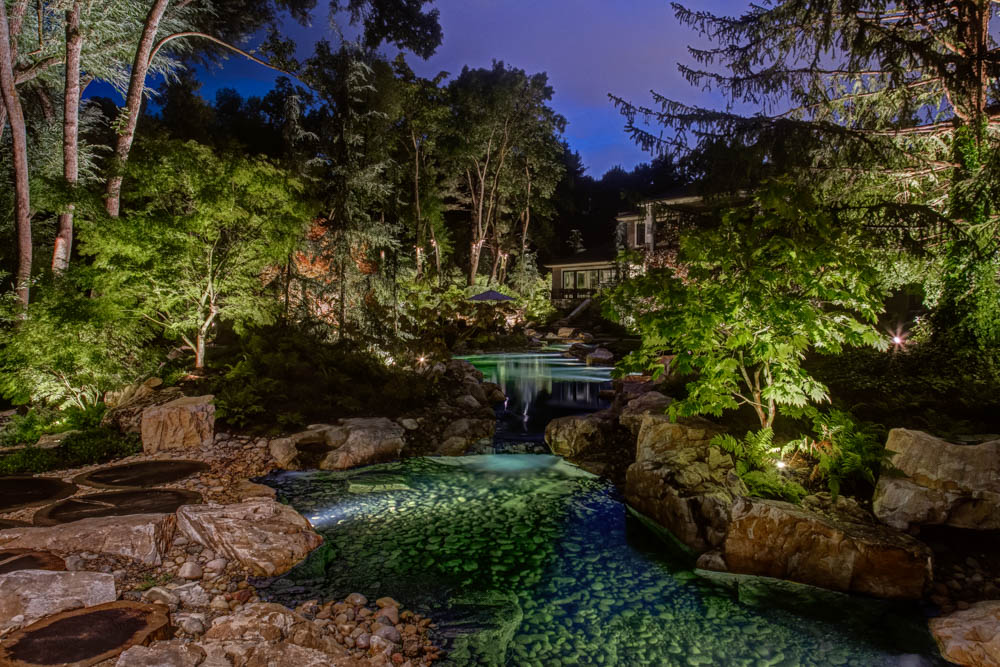
If you have a backyard pond, you know the peaceful pleasure this water feature brings to your outdoor living.
Ponds are beautiful during the day, with sunlight catching the subtle sparkle of darting fish and lilies floating lazily in the breeze.
But once the sun sets, they disappear.
Until you light them. Then your peaceful pond turns spectacular.
Waterfalls sparkle. Fountains become dramatic focal points. Pond surfaces glimmer and the lights reflect off fish as they swim past.
But how to light it? Do a pond’s best features show up with downlighting from above, or from lights submerged beneath the water’s surface?
No two landscapes are alike, so there’s no set formula for lighting a pond. We look at what Mother Nature offers, and go from there.
Let’s take a look at downlights vs. submersible pond lights and how to use them.
Pond Downlighting
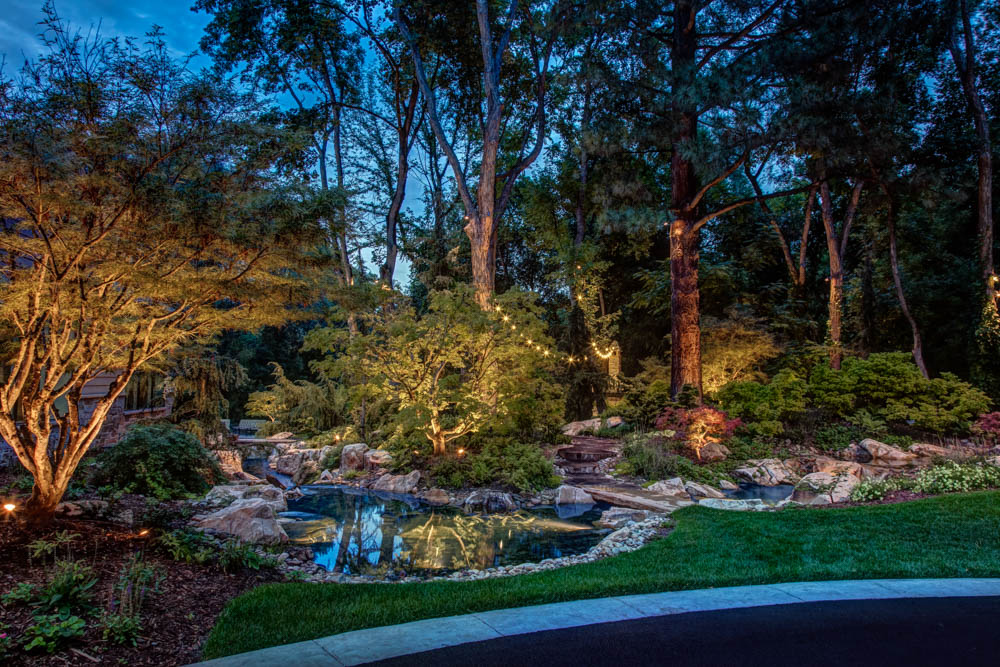
We use downlighting for ponds whenever we can.
It offers a natural, diffused light that mimics Mother Nature — which is exactly what you want when illuminating an outdoor water feature like a pond.
If mature trees surround the pond, we install lights in the branches overhead to mimic a natural moonlighting effect. This creates intriguing shadows from branches and leaves onto the pond. We install the fixtures within the tree canopy to get the best shadowing effect.
This kind of downlighting can show off not just the pond, but also the landscape around it.
Downlights last much longer than submersible pond lights and are much easier to maintain, which means less worry and more value.
Submersible Pond Lights
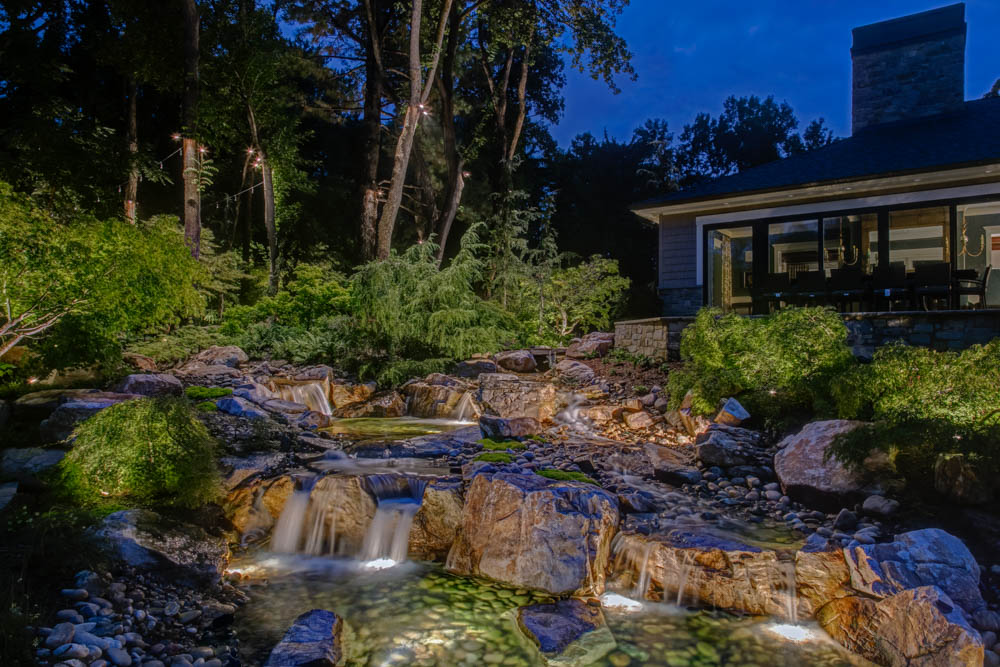
While I love downlighting for ponds, sometimes I just can’t get the angle I want or I don’t have the access I need.
Luckily, I can tuck lights underwater.
The best quality about submersible pond lights is they make the water sparkle, as the light shines up through the water.
They’re great for ponds that might have a wide waterfall, or a waterfall with multiple tiers, where I need to nestle lights into the nooks and crannies.
But I use these underwater fixtures with caution, because there is a maintenance concern.
Even the best underwater lights can take in water, which causes damage. Moss and algae can grow over the lenses, obscuring the light.
Underwater lights tend to show all of the algae, dirt and leaves floating in the pond. One more reason to keep your pond as clean as possible.
Another Pond Lighting Option: Uplights
We prefer to use directional uplights, also called bullet lights, above the water but close to the pond’s edge.
We can nestle those close to the water’s edge and hide them in the foliage surrounding the water.
They can be pointed in any direction, to cast light on the pond’s surface, to highlight foliage at the pond’s edge or to direct light toward a waterfall.
Aiming light where a waterfall hits the surface of the pond catches the air bubbles, and highlights the movement. Bullet lights are great for this.
Because these lights aren’t in the water, they hold up better over time than submersible lights.
Less Is More
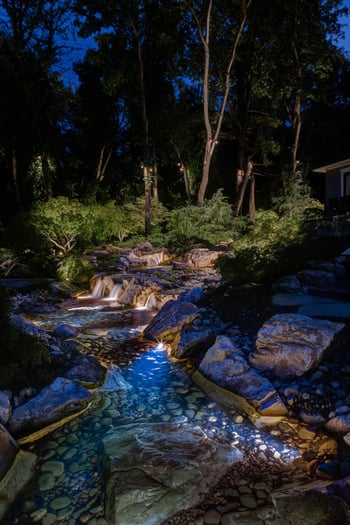
A common mistake in lighting ponds and water features is too much light. The lighting should be subtle and soft, with not too much lumen output. We typically use 200 to 400 lumens.
A water feature should be built as if Mother Nature actually showed up. Don’t install a pond in your front yard, elevated eight feet like a volcano. That would never happen naturally.
The same thing is true for the lighting. It should look like nature is lighting it.
Does the moon blast your pond with so much light you could thread a needle out there? Neither should your landscape lighting.
One of our favorite waterfall photos in our outdoor lighting photo gallery just has one light on it — a downlight from a nearby tree. It looks soft and inviting.
It shows how downlighting is the most natural way to light these water features.
Keep in mind that subtle highlights are more effective than harsh spotlights. You want to play up your pond’s best features, not highlight every single detail.
Common Pond Lighting Mistakes to Avoid
- Ignoring Clarity: If your pond is murky, submersible pond lights aren’t the best choice. You’ll just highlight the gunk. A clear, well-maintained pond will sparkle in the light.
- Creating Glare: Glare is always a big concern when lighting a pond. It’s important to position the fixtures so the light doesn’t hit you in the eye.
This takes skill and precision, especially if the pond will be viewed from more than one location.
You also want to avoid the glare of “hot spots” that come from using a single lighting source.
If I just put a light under a waterfall to make it sparkle, it looks out of place, like a glaring hot spot in the landscape. - Using Lighting Kits: Sometimes our clients happily tell us that their pond kit came with a lighting kit. Can we install it for them?
Sure, we could. We can also come back in six months when the cheap plastic and aluminum fixtures have worn out and broken down.
They’re just not high quality. You’re much better off to install high-quality brass and copper fixtures from the beginning, and enjoy your pond lighting, worry free.
Underwater Fountain Lighting
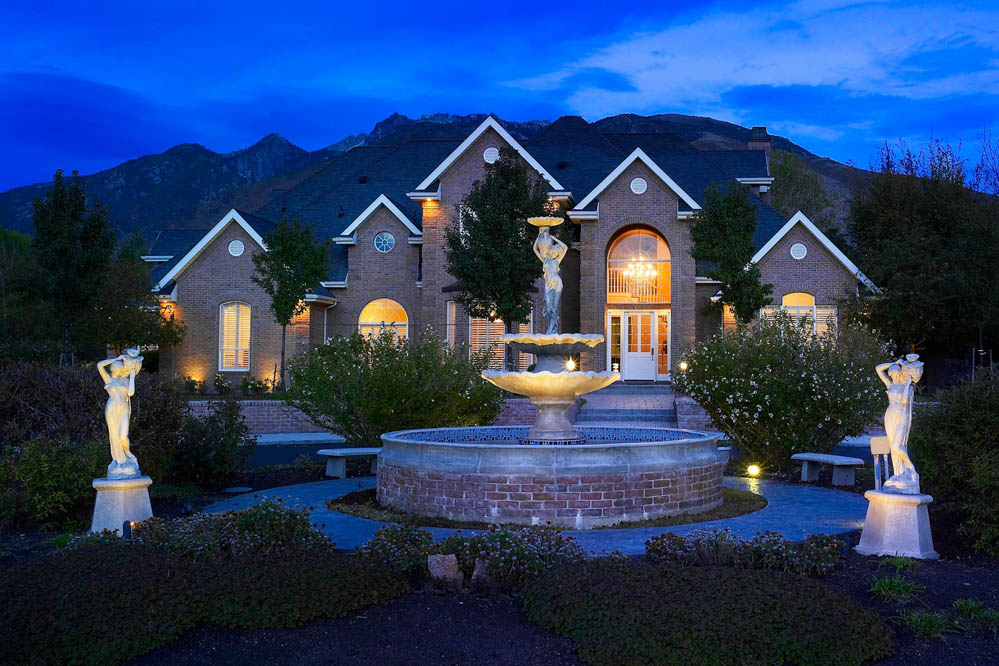
The exception to our preference for above ground lighting is in lighting large fountains.
If you have a large, tiered fountain with three separate bowls, you need to submerge the lights for a quality effect.
If you only light the fountain from the ground, you get huge shadows. You need a minimum of three lights in each bowl to achieve a beautiful 360 -degree view. These centerpiece fountains are designed to be viewed from all around, often in circular driveways or entryways.
In this case, the lights need to go under the water.
Be sure they’re brass, so they don’t corrode or warp.
If there are trees or a structure nearby, we’d add downlighting for another element of diffused light on the fountain.
Don’t Neglect The Surrounding Landscaping
A pond is part of your overall landscaping. If you light the pond, you need to light the features that surround it, for a seamless, blended look. Downlighting works nicely here.
If ornamental trees or statues surround the pond, uplighting them can create a mirror effect on the water, highlighting their reflection in the pond.
Lighting paths around the pond defines the pond edges and creates nice reflections in the water.
Trees take on a sculptural quality in the landscape with professional, artistic uplighting.
Give Us A Call
We’d love to use our artistry and expertise to professionally illuminate your pond or other water feature. Check out our photo gallery for outdoor lighting ideas.
Give us a call at (801) 440-7647 to schedule a free consultation, or fill out our simple contact form.
Located in Midvale, Landscape Lighting Pro of Utah serves customers throughout Utah’s residential areas, including Salt Lake City, Park City, Draper and Holladay. Our outdoor lighting portfolio includes projects from Salt Lake County and Utah County, to Davis County and Summit County — and beyond.
Salt Lake City (Midvale)
801-440-7647
St. George
435-932-6627
©2025 Landscape Lighting Pro
Privacy Policy
Cookie Policy